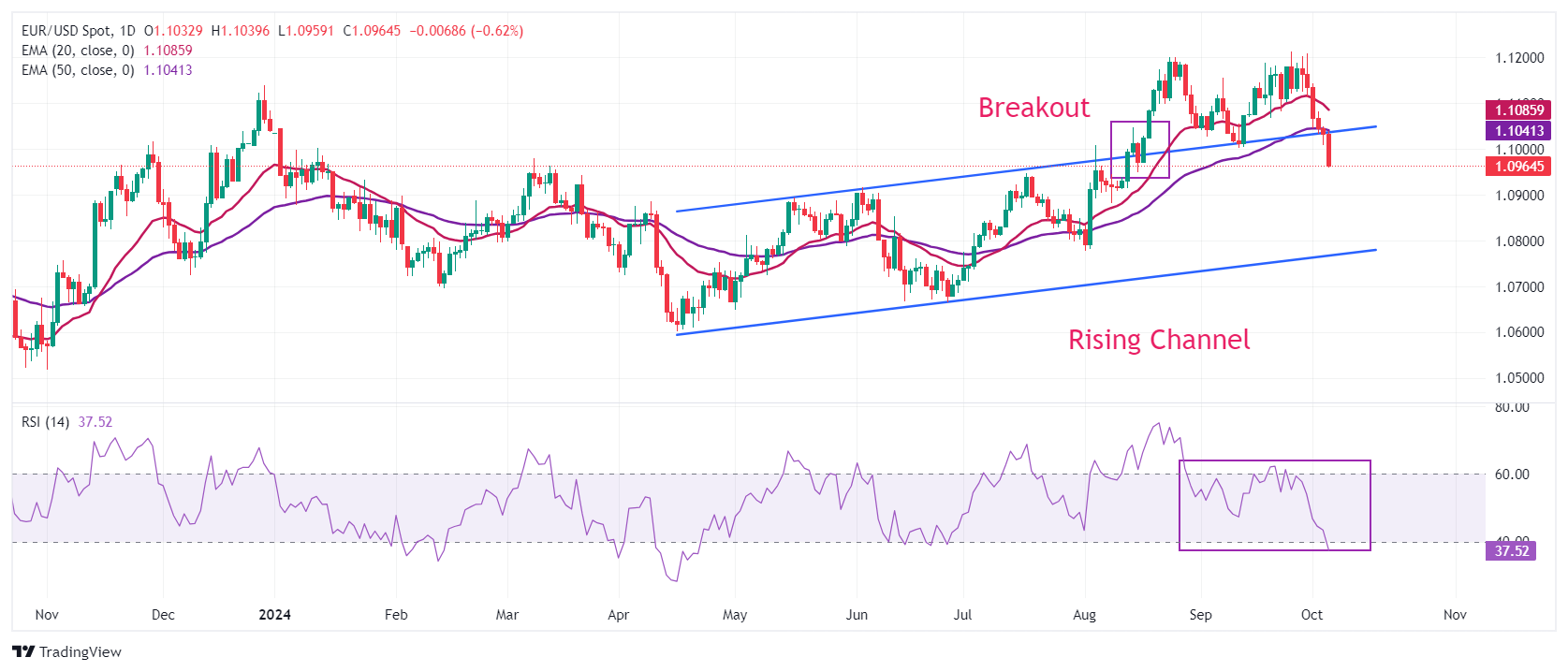- EUR/USD falls sharply below 1.1000 as US NFP surprisingly came in higher than estimates in September.
- A sharp expansion in the US Average Hourly Earnings has renewed fears of price pressures remaining persistent.
- ECB Schnabel remained concerned about the growing economic risks in the Eurozone.
EUR/USD dips below the psychological support of 1.1000 in Friday’s New York session. The major currency weakens as upbeat United States (US) Nonfarm Payrolls (NFP) report for September has strengthened the US Dollar (USD). The US Dollar Index (DXY), which tracks the Greenback’s value against six major currencies, surges above 102.50.
The US NFP report showed that job-seekers hired last month surprisingly came in higher at 254K. Economists estimated a mild slowdown in the hiring pace at 140K against 159K in August, upwardly revised from 142K. In the same period, the Unemployment Rate came in lower at 4.1% from the estimates and the former release of 4.2%. Strong hiring numbers have forced traders to pare market expectations for another Federal Reserve (Fed) large interest rate cut in November.
The Fed started its policy-easing spell with a larger-than-usual 50 basis points (bps) interest rate cut on September 18. After the Fed’s decision of jumbo rate cut, comments from Fed Chair Jerome Powell and his teammates have indicated that the central bank was more focused on reviving job growth amid confidence that price pressures are on track to return to bank’s target of 2%.
As per the CME FedWatch tool, 30-day Federal Funds futures pricing data shows that the probability of a further cut in interest rates by 50 basis points (bps) in November has declined to 10% from 33% after the release of the official employment data. Fed large rate cut prospects for November waned sharply after the upbeat ADP Employment Change data for September and JOLTS Job Openings data for August.
Meanwhile, higher-than-expected growth in the Average Hourly Earnings has renewed risks of inflation remaining persistent. Average Hourly Earnings, a key measure to wage growth, accelerated at a faster-than-expected pace to 4% from the estimates of 3.8% and the prior release of 3.9%, upwardly revised from 3.8% year-on-year. The monthly wage growth rose by 0.4%, faster than estimates of 0.3% but remained slower than 0.5% in August, upwardly revised from 0.4%.
US Dollar PRICE Today
The table below shows the percentage change of US Dollar (USD) against listed major currencies today. US Dollar was the strongest against the Japanese Yen.
| USD | EUR | GBP | JPY | CAD | AUD | NZD | CHF | |
|---|---|---|---|---|---|---|---|---|
| USD | 0.50% | 0.06% | 1.02% | 0.10% | 0.49% | 0.70% | 0.75% | |
| EUR | -0.50% | -0.43% | 0.52% | -0.38% | -0.01% | 0.22% | 0.22% | |
| GBP | -0.06% | 0.43% | 0.95% | 0.05% | 0.41% | 0.63% | 0.64% | |
| JPY | -1.02% | -0.52% | -0.95% | -0.91% | -0.53% | -0.34% | -0.30% | |
| CAD | -0.10% | 0.38% | -0.05% | 0.91% | 0.38% | 0.62% | 0.59% | |
| AUD | -0.49% | 0.01% | -0.41% | 0.53% | -0.38% | 0.22% | 0.20% | |
| NZD | -0.70% | -0.22% | -0.63% | 0.34% | -0.62% | -0.22% | -0.01% | |
| CHF | -0.75% | -0.22% | -0.64% | 0.30% | -0.59% | -0.20% | 0.00% |
The heat map shows percentage changes of major currencies against each other. The base currency is picked from the left column, while the quote currency is picked from the top row. For example, if you pick the US Dollar from the left column and move along the horizontal line to the Japanese Yen, the percentage change displayed in the box will represent USD (base)/JPY (quote).
Daily digest market movers: EUR/USD falls sharply as Fed large rate cut bets wane
- EUR/USD faces selling pressure in North American trading hours. The major currency pair extends its losing streak for the sixth trading session on Friday. The pair faces pressure as dismal market sentiment, driven by growing Middle East conflict, continues to weigh on risk-perceived assets, such as the Euro (EUR).
- Conflicts between Iran and Israel deepened after the killing of Hezbollah leader Hassan Nasrallah, in retaliation to which Tehran launched hundreds of ballistic missiles on military bases in the Tel Aviv region.
- Meanwhile, growing speculation for the European Central Bank (ECB) to cut interest rates again on October 17 has sent the Euro on the backfoot. Market expectations for ECB rate cuts have increased due to deepening Eurozone growth worries and a decline in the continent’s Harmonized Index of Consumer Prices (HICP) below the bank’s target of 2% in September.
- ECB board member Isabel Schnabel, who has remained an outspoken hawk, expressed concerns over growth risks in a speech on Wednesday. “We cannot ignore the headwinds to growth,” Schnabel said. She also remained confident about inflation sustainably falling to 2% in a timely manner, with softening labor demand and further progress in disinflation.
Technical Analysis: EUR/USD falls below 1.1000
EUR/USD extends its downside below the psychological support of 1.1000. The near-term outlook of the major currency pair has weakened as it trades slightly below the 50-day Exponential Moving Average (EMA), which stands at around 1.1043.
The shared currency pair fails to hold the breakout of the Rising Channel pattern in the daily chart, which occurred in the third week of August. The 14-day Relative Strength Index (RSI) slides below 40.00. A bearish momentum would trigger if the RSI sustains below the same.
Looking down, a downside move below 1.1000 will result in a further decline toward the 200-day EMA around 1.0900. On the upside, the 20-day EMA at 1.1090 and the September high around 1.1200 will be major resistance zones.




